115th Station Hospital Unit History

Photograph showing the entire Enlisted personnel of the 115th Station Hospital. Taken during the unit’s time at Fort Devens, Massachusetts.
Activation & Early History:
Station Hospital No. 15 was constituted in July 1923 and allotted to the Seventh Corps area. It was organized on paper at Des Moines on 29 August 1924, and then finally redesignated as the 115th Station Hospital on 29 June 1929. By General Order No. 52 of the Seventh Service Command, the 115th Station Hospital was officially activated on 1 September 1942 under the command of Captain Horton E. Hughes at Camp Atterbury, Indiana. During the first few days at the station, the cadre was seriously lacking in any significant numbers, (1 Officer and 25 Enlisted Men) and the unit did not have a permanently assigned barracks. As a result, the men initially slept in the wards of the local Station Hospital until the Camp officials formed six new barracks which were assigned to the unit. Officers gradually filtered into the unit to occupy the numerous vacancies according to the Table of Organization, and the unit also received twenty-five skilled Hospital Technicians from Billings General Hospital Fort Benjamin Harrison, Indianapolis, Indiana (Finance Replacement Training Center –ed).
As October arrived, additional personnel found their way into the 115th, including the unit’s new Commanding Officer (Lt. Col. Daniel J. Fourrier), Executive Officer (Lt. Col. Robert E. McMahon)and Adjutant (Capt. Sanches). Nurses arrived shortly afterwards and by the end of October the Hospital had almost a full complement of Officers, Enlisted Men and Nurses.

Group picture showing the unit’s Nurses. Photograph taken at Fort Devens, Massachusetts.
Training:
With the recruitment process almost complete, it was then necessary to introduce a rigorous training program to shape the newly-formed unit into a combat-ready field medical outfit. Classes in nearly every phase of the field were thrown at the recruits by zealous PT instructors. Blackout calisthenics were regularly held before breakfast was served. Marches, drill, instructions in field sanitation were carried out from dawn until dusk – a stark contrast to the relatively laid back attitude of the former Commanding Officer!
As the training period continue to develop and grow, so too did the rumors of a potential movement overseas. Many of the Hospital’s personnel felt sure that a move to a Port of Embarkation would be made soon, but towards the end of October, orders were received for a move to Fort Devens, Massachusetts (Reception Center for all recruits coming from New England –ed).
A week of additional training took place with regular practice of entrucking and detrucking of personnel, and the packing and unpacking of unit equipment. Additional changes were made to the Table of Organization, which saw a number of the Technicians leave the unit for assignments to other Medical units in the area.
The unit officially left Cp. Atterbury for Ft. Devens on 2 November 1942 via the mainline railroad. The journey was completed the following day, and after detraining all personnel were directed to the Station Hospital where warm food was to be served.
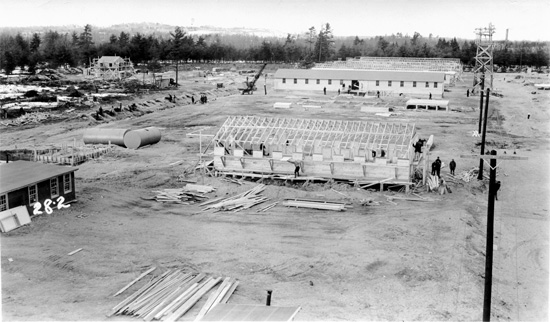
Illustration showing the construction of hospital buildings at Fort Devens, Massachusetts. These buildings would later be occupied by the 115th Station Hospital.
Courtesy First Infantry Museum, Cantigny Park Illinois (via Andrew Tabak)
The first two weeks at Ft. Devens were entirely dedicated to the completion of unit and specialist training, with regular appointments made to the Station Hospital. With the training deemed to be a complete success, passes and furloughs largely became the order of the day. Many members of the 115th enjoyed a three-day pass for Christmas and New Year, and each Sunday was, for the first time since the unit’s activation, dedicated to church services, hobbies and other extra-curricular activities. Local members of the organization lived off-post with their families, while Enlisted personnel slept on folding cots for the first few weeks at the new station. However, quickly all ten assigned Enlisted Barracks were filled, and wooden bunk beds were installed with fresh linen; much to the pleasure of the inhabitants!
After two days at Fort Devens, the unit’s complement of Medical Administrative Corps Officers arrived: Abram, Hurwitz, Langdon, Ellenson, Huntman, Pahl, Runyon, McNamara and Wittman.
During this period, a number of other changes were made to the unit’s personnel. Enlisted personnel were lost either through O.C.S. (Officer Candidate School –ed), the Climatic Research and outright commission in the Sanitary Corps. All over-aged personnel were transferred out of the unit too, and replacements poured in quickly. This meant that additional training was required, especially since a number of new Officers had also joined the unit during this period. The first group of Army Nurse Corps members also arrived and were promptly joined by the American Red Cross complement.
It was not all work at Fort Devens, however. Regular appointments were made at the Officers’ Club, and numerous USO shows were organised at taverns and bars in the local area. It was during this period that the unit also formed its own orchestra, the “Jumpin’ Jive of the 115”, which under the direction of Solov, regularly played concerts to the station.
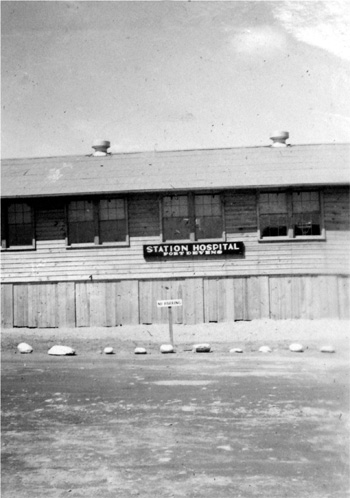
Exterior view of the Station Hospital building at Ft. Devens.
Courtesy First Infantry Museum, Cantigny Park Illinois (via Andrew Tabak)
As the weeks rolled on and changes to the Table of Organization continued to be made, it was clear to everyone that the 115th was preparing for the “big one”. The general consensus of the rumor-mongers was that England was to be the destination, but no official orders were received.
Finally on 3 July 1943 official movement orders were sent to the 115th, the unit would indeed be heading overseas to England imminently.
Preparation for Overseas Movement:
Preparations were immediately made for the unit’s movement to Camp Shanks, New York (the largest Embarkation Camp in the US –ed), where it would board troop transport for the United Kingdom. During the stay at Cp. Shanks, further slight amendments were made to the unit’s T/O, and by the time departure day had arrived, the 115th was up to its full authorized strength of 120 Officers and Nurses, and 392 Enlisted Men.
The unit departed Camp Shanks and headed to the New York Port of Embarkation via railroad, where its personnel boarded the USS Santa Elena (a requisitioned and converted passenger cruise ship –ed). The ship finally left the New York Port of Embarkation on 15 July 1943. The ship joined a destroyer-guarded convoy which zig-zagged across the Atlantic, a voyage lasting for 11 days.
United Kingdom:
The USS Santa Elena finally arrived into the port of Gourock, Scotland on 26 July 1943, and the debarkation of the unit’s personnel and unloading of equipment took place immediately. The Hospital staff were then split into two large groups, each boarding a separate train which would take them on an overnight journey to Tavistock, Devon, England. The final leg of the journey was completed the following morning by Army transport, which carried the 115th from the rail station in Tavistock to Plaisterdown Camp, Dartmoor.
The advance party had already traveled to this new site a few days earlier in order to prepare and adapt the buildings for use as a hospital complex. The incredible work done by the advance party meant that the unit was able to open a 750-bed Hospital almost immediately upon arrival at the facility. The unit initially operated as a General Hospital for the numerous US Army units stationed in and around Plymouth.
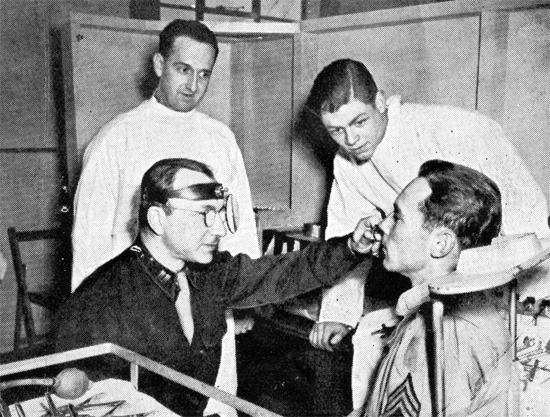
Captain Anthony J. Della Rocca examines a patient in the EENT clinic at the 115th Station Hospital.
Heating facilities at the new location were called grossly inadequate. They were augmented by insulating all concrete floors with pitch mastic and by installing 2,260 new stoves. The sewage system was also inadequate, and only part of the needed improvements had been made by the end of 1943. Laundry and washing facilities were generally found to be acceptable.
An unannounced operational test was conducted at the Hospital on 24 February 1944. 284 simulated casualties arrived from the Tavistock railhead by ambulance. They were all processed for admission within 70 minutes.
Between August and the end of 1943, it had cared for more than 10,000 patients, of whom some 4,000 required diagnostic hospitalization and nursing. The outpatient department at the Dental Clinic dealt with approximately 8,000 procedures during the same period. The influx of surgical cases made it clear relatively quickly that the 115th was seriously lacking in manpower, and numerous requests were made to senior Medical Department staff in the United Kingdom for additional technicians and medical professionals. Several of the job vacancies were filled by British civilians, but this solution offered only short-lived respite. As the number of American military personnel stationed in the area began to increase in the build-up to the Normandy invasion, so too did the Hospital’s workload.
On 15 May 1944, the unit received additional orders for its function during the forthcoming military invasion of the Normandy coast. It was designated as Hospital Plant No. 4101 and Transit Hospital No. 2 for the evacuation of casualties from mainland Europe. It was realized that the 750 beds currently available at the facility would be unable to cater for the anticipated demand. As a result, the capacity was increased by adding Ward Tents, initially offering an accommodation of 1,180 beds, and then later 1,487 beds. This was achieved by adding 10 beds to each of the regular wards, and having sufficient bed space for 345 men in a total of 23 Ward Tents, each with 15 folding cots. Covered walk ways were also constructed, which connected the new Ward Tents and all patient areas together.

General view showing technicians hard at work in the Hospital’s laboratory.
News of the invasion was received via wireless at the facility on the morning of 6 June 1944, and all staff were instructed to prepare the Hospital to receive its first trainload of patients. After much waiting, the first casualties were unloaded at the complex on the morning of 28 June, when 292 men arrived via train. Contrary to anticipation, the workload of the Hospital fell after the initial invasion, since casualties were not as high as expected, and so general work at the facility reduced. Further patients were received steadily until the end of the year as follows (which represented the highest patient census in the unit’s history at 1,364):
6 October 1944 > 292
9 November 1944 > 270
27 November 1944 > 319
14 December 1944 > 244
21 December 1944 > 270
25 December 1944 > 279
The winter was particularly hard, and the main access route to Plaisterdown Camp was thick with ice and snow. The 115th’s Motorpool made improvised snowploughs with boards at the front of many unit vehicles.
As 1945 arrived, the number of admissions to the 115th started to drop for the first time since the invasion began. A number of larger hospital units had been established in mainland Europe, closer to the frontline to deal with the casualties, which explains the decrease in workload for this period. Finally on 25 April 1945 the unit was given advance verbal warning of its transfer to the continent from the Headquarters of the 801st Hospital Center. As a result, all wards were closed down, and the remaining 48 patients were transferred to the 112th Field Hospital (located at Newton Abbot, Devon –ed). The facility at Plaisterdown Camp was officially closed on 28 April 1945, and all preparations were made for the impending move.
All large medical and military equipment was packed and sent from the camp by 20 May, leaving only personal equipment and TAT (“To Accompany Troops” –ed) materiel to be moved with the unit. During the morning of 23 May 1945, the 115th left Plaisterdown Camp via motor transport for Tavistock rail station, where it boarded a train to Southampton. Upon arrival at Southampton, the unit then embarked for Le Havre, France.
France:
On the morning of 24 May 1945 the 115th debarked upon temporary piers in the bomb-wrecked port of Le Havre. The Nurses then proceeded by truck to Mesnières-en-Bray, while the male personnel cruised up the Seine aboard LCIs (Landing Craft, Infantry –ed) to Duclair. From Duclair, the three mile march to Camp Twenty Grand was accomplished on foot with full packs, and the 115th didn’t get bedded down in cots until the early hours of the following day.
The unit remained at Cp. Twenty Grand for two weeks.
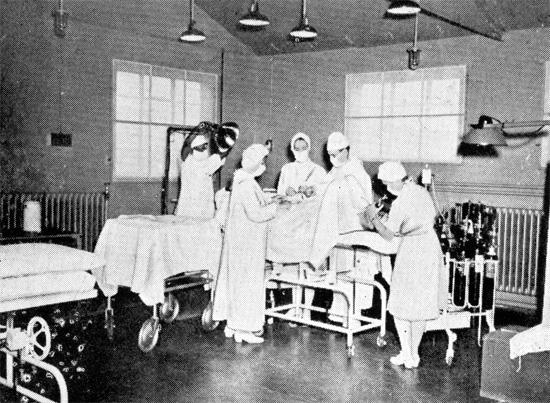
An operation in progress at the 115th Station Hospital.
On 6 June 1945, the unit’s Nurses left Mesnières-en-Bray for Paris, but upon arrival in the French capital, it seemed that no-one was expecting them! After an overnight rail trip in chair cars, the Nurses waited from 0800 hours to 2200 hours in the public railway station before arrangements were made to move them on to Metz, the next stop for the 115th Station Hospital. The balance of the unit left Camp Twenty Grand the same day, and traveled to Metz via rail in traditional “40 & 8 cars”.
The journey took 36 hours, and upon arrival the unit immediately detrained and boarded trucks which took everyone to L’Ecole Professionnelle, a school located near to the city which was to house the 115th.
The facility was shared with the 237th General Hospital until 21 June, after which time the 115th was attached to the 820th Hospital Center. Very little activity was noted during this period however, and the Hospital soon received orders to once again change station. On 20 July, the unit’s Commanding Officer received a telephone call alerting him of the impending move into Germany.
A sizeable advance party was prepared, consisting of 12 Officers and 111 Enlisted Men. The party left Metz at 2300 hours on 26 July 1945 and traveled by motor convoy to the unit’s next home.
Germany:
In August 1945 the unit completed its move to Augsburg, Germany where it occupied the General-Kneußl-Kaserne. The first patients were not received at the new facility until November 1945, and so the unit largely acted as a Dispensary for the local inhabitants and military troops. Much construction and conversion was required to the building in order to make it ready to receive patients, and as a result the unit’s Table of Organization was reduced to 250 beds, and further reduced before the patients arrived to only 150 beds.
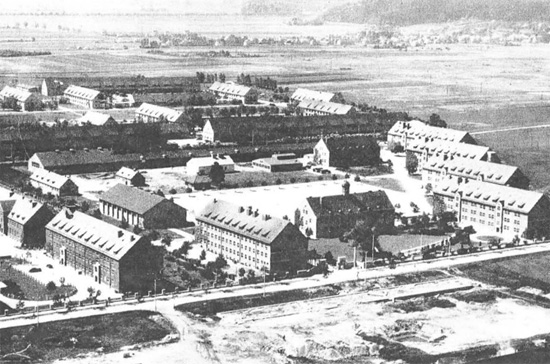
Aerial view showing the General-Kneußl-Kaserne occupied by the 115th Station Hospital in Augsburg, Germany.
The Kaserne was built in 1936, and after the fall of Augsburg it was occupied by Headquarters, Seventh United States Army for a short period. The site occupied approximately 15 acres, with fourteen comparatively new buildings in good condition. The conversion of the plant from an infantry kaserne to a hospital was eventually completed in a satisfactory fashion.
The facilities of the hospital were consolidated so that the unit could be operated with a minimum number of personnel, which finally allowed many of the unit’s “high pointers” the opportunity to get their ticket home!
The treatment of patients was confined to two buildings which housed all wards, clinics and out-patient services. All messes, both for military and civilian personnel were placed in a single building. Quarters for Medical Department personnel were adequate and comfortable, located within the kaserne itself. During the time at in Augsburg, all male Officers occupied requisitioned billets near the facility.
Recreational activities were plentiful around the kaserne. An Enlisted Men’s Club was established in a converted stable in the grounds, and the popular areas of Garmisch and Berchtesgaden were also easily accessible to Hospital personnel. The city of Augsburg itself also had a number of recreational establishments and historical points of interest which were often the topic of conversation after passes and furloughs had been completed.
During this period, the Hospital mainly served units attached and assigned to the Augsburg Military Post. The military strength of the post was approximately 3,500 and dependents in the community numbered about 600. Hospital beds and facilities were adequate to care for this number, but the Outpatient Department placed a great burden on the Medical personnel. Although it was significantly reduced in bed capacity, the facility was fully equipped to perform routine laboratory, x-ray, EENT, BMR and surgical procedures. However, the facilities were generally underused, in favor of transferring such cases to other hospitals in the area where trained specialists were stationed.
During 1946, the patient census reached a high of 256 once, but the average was 140. By the third quarter of the year, the surgical section elevator was finally installed and it was no longer necessary to carry patients upstairs on litters.
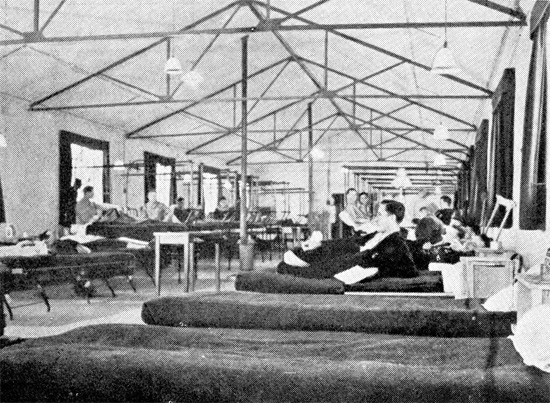
General view of a surgical ward at the 115th Station Hospital.
On 3 September 1946, Col. James C. Van Valin was relieved as the unit’s Commanding Officer, and was replaced by Lt. Col. George W. McCoy, Jr., MC.
The End:
By 31 March 1947, the patient census was down to 94 plus one baby. Some wards had to be closed because of shortages of personnel and also of coal to heat the entire kaserne properly. The 115th continued to operate in a limited capacity at the kaserne until the station was officially closed on 20 July 1947. All patients were transferred to the 98th General Hospital located in Munich. Many of the Hospital’s staff were returned to the ZI for re-assignment or demobilization from the Army.
Later the same year, the 115th Station Hospital, which now existed only on paper, was officially deactivated, and re-designated as the 829th Field Hospital.
The 115th’s Commanding Officers were assigned as follows:
| Captain Horton E. Hughes, MC | 1 September – 13 October 1942 |
| Lieutenant Colonel Daniel J. Fourrier, MC | 13 October 1942 – 31 October 1944 |
| Lieutenant Colonel Robert E. McMahon, MC | 1 November 1944 – September 1945 |
| Colonel James C. Van Valin, MC | September 1945 – 3 September 1946 |
| Lieutenant Colonel George W. McCoy, Jr., MC | 3 September 1946 – 20 July 1947 |

Group photograph showing the 115th Station Hospital Officers.
Roster:
Officers:
| Abram, John C. |
Leatherman, Kenton D. |
| Badger, Walter L. |
Leslie, George L. |
| Barron, Stephen F. |
Lipton, Sidney A. |
| Batten, Douglass H. |
Magit, Jack R. |
| Biddlecombe, Duncan |
Manning , Jack W. |
| Bigelow, Henry T. |
McIntire, Barron F., Jr. |
| Bosscher, Gerard P. |
McMahon, Robert E. |
| Brill, Robert |
McNamara, Bernard T. |
| Brown, Wayne B. |
Meiere, Cheney M. |
| Carroll, David S. |
Mesick, Martin R. |
| Cole, Irving D. |
Mulhern, Philip F. |
| Daniel, Kenneth, J. |
Mulrooney, Raymond E. |
| Della Rocca, Anthony J. |
Park, Felix R. |
| Dougherty, William F. |
Prentiss, Russell I., Jr. |
| Edwards, Earl J. |
Reed, Frederick I. |
| Ellenson, Louis |
Romm, Barnet I. |
| Feiring, Emanuel H. |
Runyon, Merlyn W. |
| Fisher, George S. |
Ryan, William |
| Fourrier, Daniel J. |
Sadler, LeGrande W. |
| Gannon, Joseph M. |
Schlicher, Norman R. |
| Geary, James F. |
Setz, Leo A. |
| Golden, Abe |
Simms, Donald M. |
| Grau, Eugene C. |
Simses, John P. |
| Harrison, George W. |
Sokoloff, Oscar J. |
| Hughes, Horton E. |
Stappenbeck, Richard F. |
| Hurwitz, Joseph |
Steefens, Charles T. |
| Irvine, Vernon K. |
Strohl, Everett L. |
| Irwin, Willard J. |
Taplin, George V. |
| Jellinger, David L. |
Tynan, John W. |
| Judd, Marvin E. |
Van Ormer, William A. |
| Kemp, Robert C. |
Wally, Edward S. |
| Langdon, Roscoe |
Wittman, John S. |
| Lazaro, Ladislas |
Wynne, Edwin A. |

Unidentified members of the 115th Station Hospital gather round an intense card game inside their barracks. Photograph taken in England.
| Nurses: | |
| Aldrich, Ella O. | Hyman, Mary F. |
| Alger, Marcia R. | Jensen, Margie M. |
| Artz, Elizabeth | Jones, Pauline |
| Barr, Mildred K. | Kaneshire, Neddie |
| Barrett, Doris K. | Kitzerow, Helen C. |
| Beall, Martha M. | Kusmierz, Josephine |
| Bennett, Bea P. | Lagomarcino, Estella J. |
| Blethen, Jacquelin C. | Lewis, Vivian M. |
| Bott, Dolores A. | Lindholm, Mildred P. |
| Brown, Beatrice L. | McDaniel, Marguerite |
| Burton, Grace M. | Markesich, Mary M. |
| Campbell, Eleanor M. | Meehan, Mary E. |
| Cauley, Anna E. | Meeks, Lucile G. |
| Chaney, Ethel P. | Metzler, Eugenia D. |
| Connor, Mary D. | Molyneaux, Pauline |
| Cox, Lois A. | Oaf, Sarah R. |
| Cunningham, Mary L. | Park, Helen E. |
| Eger, Elizabeth A. | Pennyfeather, Kathleen M. |
| Engle, Margaret E. | Philips, Margaret E. |
| Engler, Rosella E. | Pitzer, Geraldine F. |
| Farrell, Aileen M. | Pletta, Leona M. |
| Fetters, Marguerite | Rhinehart, Alice M. |
| Fish, Jessie M. | Richard, Stella M. |
| Flautt, Wilma D. | Rowe, Kathleen M. |
| Ford, Olive R. R. | Rusher, Anna D. |
| Frazer, Ellen A. | Sherman, Elinor B. |
| George, Amelia E. | Smith, Jane F. |
| Giard, Pauline L. | Snyder, Kathryn R. |
| Gibbs, Martha E. | Stewart, Blanche M. |
| Goodrum, Margaret L. | Sydenstricker, Norma J. |
| Gossett, Nettie L. | Taylor, Eula C. |
| Gothe, Rose E. | Tierney, Joan M. |
| Graff, Cecilia M. | Tuller, Harriett L. |
| Guillot, Bertha J. | Tyner, Pearl |
| Hale, Florence C. | Ugai, Marguerite N. |
| Harrington, Anne | Vanish, Susanne |
| Hayden, Lena M. | Wall, Retta J. |
| Hearing, Juanita M. | Wherry, Maxine |
| Heil, Martha V. | Wilson, Lillian R. |
| Hilston, Edna L. | Wiltse, Sara E. |
| Hopson, Elisabeth W. | |
| American Red Cross Workers: | |
| Barnhart, Henri | Kurtz, Jane |
| Cosand, Phyllis M. | Lannelle, Madeline |
| Ford, Gwendolyn | McCullough, Isabel |
| Haberkorn, Estelle | Readhead, Dorothy E. |
| Keane, Lucina | Ritterman, Rose |

Supplies and equipment arrive at the 115th Station Hospital in a locally-acquired wooden cart. Photograph taken during the unit’s time in England.
| Enlisted Men: | |
| Acosta, Pedro | McIntyre, George J. |
| Aiesi, Joseph | McKenzie, Merle C. |
| Ames, Charles B. | McKenzie, Shelva |
| Amos, Junior | McRae, Oddis D. |
| Aurigemma, Martino C. | MacCurdy, Roland W. |
| Bailey, Charles L. | MacKinnon, Elmer A. |
| Bailey, Orban D. | MacLean, John E. |
| Baker, Charles E. | MacLeod, Murdock A. |
| Bankert, Samuel O. | Madden, William G. |
| Barnicle, Harry A. | Maddern, Warren S. |
| Barrett, Thomas S. | Major, Joseph E. |
| Barron, Walter | Manire, Bela N. |
| Bartner, Milton | Mann, Edwin J. |
| Baxter, Melvil D. | Manson, James A. |
| Bell, Warren S. | Manson, Lesly A. |
| Bigda, Edward S. | Martin, Alexander |
| Bishop, William J. | Masselli, Albert |
| Blevins, Robert D. | Massingale, George K. |
| Blumhardt, William A. | Mastowicz, Joseph B. |
| Blyther, Hollis L. | Matera, Rocco |
| Boll, Ernest V. | Mehegan, William E. |
| Booth, Burk H. | Metzgar, Herbert T., Jr. |
| Booth, Roscoe M. | Meyers, Abe |
| Boros, George M. | Miliano, Frank |
| Boulds, Clarence | Miller, William H. |
| Bowden, Frank J. | Millner, Thomas M. |
| Bozzarelli, Salvatore | Mitchell, Horace G. |
| Bradley, George F. Jr. | Morris, Spiro P. |
| Brann, Phillip F. | Morris, Thomas P. |
| Brown, Earl A. | Murawski, Edmund |
| Brown, Earl G. | Natalizio, Joseph L. |
| Browning, Lester S. | Navratil, Adolph E. |
| Brumbaugh, Levi O. | Neal, Homer L. |
| Bruno, Vincent | Nelso, Peter R. |
| Bryden, Norman S. | Neuhoff, Alfred F. |
| Burg, John | Newton, Russell E. |
| Burns, John J. | Nichols, Harold M. |
| Butler, Donald C. | Nicolella, Mario V. |
| Byrd, Gurnie E. | Norris, Dale R. |
| Caesar, Aloysius A. | O’Connell, William J. |
| Calabrese, Albert E. | O’Keefe, Franklin W. |
| Caldwell, George E. | Onufer, George |
| Campanella, John A. | Osborne, William B. |
| Canario, Anthony S. | Pagan, George |
| Caramello, Fred | Pagano, Amedeo |
| Carter, Roy H. | Palmer, Ernest |
| Casella, Anthony | Panciera, John J. |
| Castillo, Manuel | Pannell, Clell P. |
| Cavazos, Tomas | Pape, Edwin W. |
| Chadwuck, Walton W. | Passino, Frederick B. |
| Chapman, Elmer B. | Patriarca, Joseph |
| Chartier, Dona N. | Peloquin, Lucien E. |
| Chartier, Vincent D. | Perna, Jack T. |
| Chase, Daniel A. | Peterson, Harry |
| Ciccoritte, John | Phinney, Burpee G. |
| Clark, Hazen B. | Pietsch, Henry G. |
| Clark, John G. | Pockey, James J. |
| Clark, William R. | Podolske, John J., Jr. |
| Cliff, Milford G. | Polak, Clement A. |
| Cobuccio, Patsy | Polanowski, Leonard J. |
| Coulon, Maurice A. | Polsky, Charles |
| Crahan, Paul M. | Pool, Ralph L. |
| Cramer, Carl J. | Porcaro, Joseph D. |
| Crandall, Maurice | Potocki, Antoni |
| Cronin, Cornelius J. | Priest, Donald |
| Cronin, John J., Jr. | Raab, Edward J. |
| Curtis, Oliver W. | Raimondo, Carmen N. |
| Darnell, James F. | Rajzman, Daniel |
| Davey, Warren E. | Rash, J. C. |
| David, Joseph S. | Raulerson, William C. |
| Davis, Robert C. | Reeves, Emmett W. |
| Deal, Lynwood H. | Reifsnider, Melvin J. |
| Delorey, Christopher H. | Rhoads, William G. |
| DeMarse, Frederick W. | Rhodes, Earl E. |
| DeWitt, Joseph J. | Ricci, Walter J. |
| Dickerson, Harold V. | Richards, Lincoln R. |
| Dicosola, Nick | Riedesel, Arthur J. |
| DiMatteo, Mario J. | Riggin, Weston A. |
| DiSette, Alexander S. | Riley, Charles J. |
| Donnelly, Cornelius J. | Rizzotto, Anthony C. |
| Donovan, William J. | Robertson, James B. |
| Dorr, Oram F. | Roemke, Stanley A. |
| Dowis, Frankie A. | Rogers, James R. |
| Dragner, Anthony | Romando, Joseph P. |
| Dukes, James B. | Rooney, Robert G. |
| Dumont, Robert R. | Rosencrantz, Abraham |
| Dykstra, Daniel | Rosenfeld, Samuel M. |
| Easterday, Walter D. | Roy, Charles E. |
| Eck, George R. | Russo, William |
| Edwards, James M. | Ryan, Edward A. |
| Eldridge, Hollie | Ryan, James J. |
| Elliott, Leonard M. | Sagan, Stanislaw P. |
| Emery, Raymond L. | Salaras, Michael |
| Evans, Fred R. | Salazar, Humberto F. |
| Farley, William A. | Samson, Meyer |
| Fay, Thomas C. | Samuelson, Walter E. |
| Filiberti, Louis J. | Santinello, John J. |
| Finkel, Isadore | Savage, Raymond W. |
| Finley, Stephen H. | Schieffer, Hubert A. |
| Fisher, Charles E. | Schill, Roy T. |
| Fisher, Norman W. | Schmal, Raymond W. |
| Fitzpatrick, Joseph L. | Schreider, Arnold M. |
| Fleming, Emza | Schroeck, Harold J. |
| Fliss, Frank T. | Scioneaux, Rodney P. |
| Flook, William | Scott, Anthony J. |
| Fontana, Jerome | Scott, Fred W. |
| Ford, Carl C. | Scully, Michael A. |
| Fox, John H., Jr. | Seskarski, Raymond L. |
| Foy, William E. | Seybold, Donald M. |
| Francis, Paul | Shelton, Joe H. |
| Fraser, Andrew J. | Siford, Alden E. |
| Freeman, Harold D. | Singer, Philipp |
| Friedman, Abraham L. | Slattery, Adolph J. |
| Fulk, Lehman B. | Slocum, Edwin A. |
| Funk, Edward F. | Smayda, Frank M. |
| Furchak, Frank S. | Smegiel, Edward S. |
| Gallipoli, Frank J. | Smith, Archie N. |
| Gaskill, Nathan L. | Smith, Charles A. |
| Gaudette, Alfred | Sola, Peter |
| Georgetsos, Thomas K. | Sparkman, James G. |
| Gibson, Walter J., Jr. | Spears, Barbie F. |
| Gilbert, Douglas A. | Spoor, Latham W. |
| Gilman, Myer | Springer, Frederic N. M. |
| Ginn, James E. | Stach, Charles F. |
| Goff, Delmer C. | Stevens, Milton L. |
| Goldberg, Jack M. | Stick, Earl R. |
| Goncalves, Agostinho | Stickels, Bernard F. |
| Goode, Kenneth R. | St. John, Allen M. |
| Goodin, Russell A. | Stone, William V. |
| Gordon, Harold O. | Stoner, William J. |
| Gorwell, William L. | Stout, Asher F. |
| Gotofsky, George | Sullivan, Cornelius P. |
| Grabitz, William C. | Sullivan, John F. |
| Grace, Russell L. | Supsie, John J. |
| Greer, James J. | Surniak, William S. |
| Griffin, Ernest W. | Surowiecki, John S. |
| Grossman, Bernard L. | Sylvester, John |
| Gruenebaum, Werner | Tainsh, William D. |
| Gunter, Ivan T. | Talkevich, George J. |
| Haftl, Walter C. | Tallman, Lawrence W. |

Patients smile for the camera inside one of the wards at the 115th Station Hospital, England.
| Hagerty, William J. | Tassoney, Rickey |
| Halle, Lyle W. | Taylor, Charlie B. |
| Hammond, Harold F. | Taylor, Earl F. |
| Hammond, John B. | Taylor, Glennwood M. |
| Hardy, Thomas L. | Taylor, Russell |
| Harkin, John E. | Tohorzewski, Anthony F. |
| Hartwell, Neil W. | Terpak, Andrew P. |
| Hawkins, Edward | Terrell, Luster O. |
| Hayle, Carroll J. | Thompson, Melvin R. |
| Haynes, Ralph A. | Thomson, John E. |
| Heaton, Harold G. | Toll, Howard H., Jr. |
| Heine, Joseph | Trested, Edward E. |
| Helmace, Steve F. | Trisoline, Peter W. |
| Hernandez, Mauricio L. | Tritt, Myron V. |
| Hess, Richard F. | Tumpis, Anthony H. |
| Hill, Harlan L. | Upton, Leonard L. |
| Hockensmith, John F. | Uva, Anthony F. |
| Holben, Clarence L. | Vanbebber, Herman M. |
| Honeycutt, O. C. | Vance, Hurl |
| Hooper, George E. | Verhaeghe, Oscar |
| Huffman, Kenneth R. | Victor, Albert W. |
| Ijams, Joe H. | Violante, Louis C., Jr. |
| Innes, Wilbert F., Jr. | Vieira, Manuel V., Jr. |
| Jacques, Sevigne | Voegtle, Clemens A. |
| Janvrin, Gordon A. | Vranas, Nicholas J. |
| Jarusewski, Theodore F. | Wallace, Raymond L. |
| Jeffries, Murray J. | Waller, Sander J. |
| Jenks, William A. | Wambold, Charles W. |
| Johnson, Randolph T. | Warren, Billie D. |
| Jones, Jack W. | Waschin, George |
| Kalish, Harry | Waterman, Charles F. |
| Kane, Francis J. | Webb, Gene R. |
| Karlage, Joseph F. | West, Richard C. |
| Kelley, Donald F. | White, William E. |
| Keppler, Richard E. | Whitlock, George A. |
| Kersey, Carl C., Jr. | Wilber, Marvin L. |
| Kobus, Edmund B. | Wildman, Frederick L. |
| Koishal, Harry G. | Williams, Leslie J. |
| Kossifos, Nicholas J. | Wise, Willard |
| Kukleski, Theodore | Witham, Willard W. |
| Lacek, Andrew, Jr. | Wood, Edmund S., Jr. |
| Lahrman, Frederick M. | Woodland, Donald F. |
| LaMontagne, Gerald E. | Woods, Paul E. |
| Lane, David T. | Woolf, Alexander H. |
| LeBlanc, Wilfred J. | Word, DeWayne M. |
| Levinson, Abe | Wortman, Delwynne B. |
| Loeb, Siegfried F. | Wright, Richard D. |
| Lom, Nye W. | Wrona, Bronislaus J. |
| Looper, William R. | Yoder, Fred L. |
| Lorincz, Michael J. | Yourko, George J. |
| Lung, Eng | Zambito, Louis P. |
| McCabe, Gerald R. | Zarin, Isadore |
| McCabe, John J. | Zelezny, Cyrill J. |
| McCarthy, Thomas F. | Zellers, Paul B. |
| McDonough, Joseph C. | Ziolkowski, Edward S. |
| McFarlane, Melvin S. | Zonn, Max |
| McInerny, George F., Jr. | Zuzzio, Albert A. |
| McInnis, Charles F. |
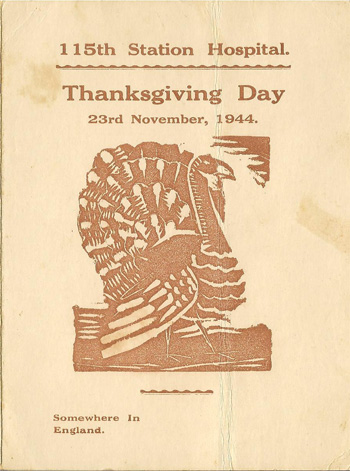
Illustration showing the front cover of a Thanksgiving Day ceremony menu. The festivities were held at the 115th Station Hospital, “somewhere in England”.
The authors would like to sincerely thank Becky Vickery, daughter of Tec. 4 John B. Hammond (ASN:34196631) who served with the 115th Station Hospital during WW2. Becky kindly provided us with important documents and literature relating to her Father’s unit which allowed the editing of this Unit History. Becky also kindly forwarded numerous photographs to illustrate this article, as well as documents that were provided by Paul Riedesel, son of Arthur Riedesel who also served with the 115th.
